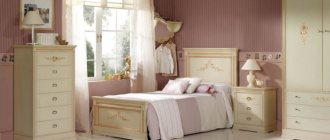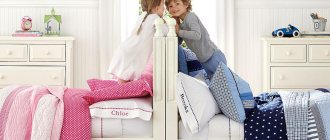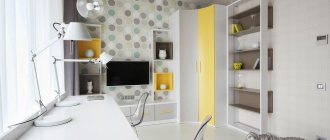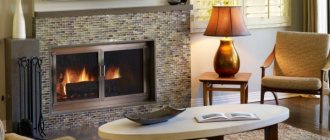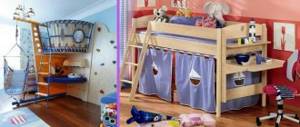SHARE ON SOCIAL NETWORKS
FacebookTwitterOkGoogle+PinterestVk
What could be easier than purchasing lamps for a decorated children's room?! There are many models available. However, this approach is wrong. The lighting method and types of lamps must be determined at the design stage, since electrical wiring must be connected to their location. Design is also important, since a chandelier in a children's room can determine the design style.
When choosing a chandelier for a nursery, it is important to consider not only its design, but also its placement
Requirements for artificial lighting in a children's room
Lighting a children's room is an important point in creating conditions for the full development of a child. Daylighting is a must. No features or methods of placing interior items should interfere with the free flow of natural light.
Proper lighting is an important point in creating a comfortable nursery interior
In the morning and evening hours, it is necessary to provide the room with artificial light. For these purposes, you should purchase and hang lamps for the children's room. They may differ significantly from lighting fixtures intended for other residential premises, since the latter are more decorative-oriented. Other requirements are imposed on children's lamps, based on safety:
- Protection against electric shock. All current-carrying parts to the lamps must be hidden in accordance with electrical standards.
- Ensuring mechanical safety. It is worth choosing lampshades made from more durable materials that will not break if hit by a ball or cube.
- Prevention of release of harmful substances. For this purpose, you should be sure to choose lamps with an acceptable degree of incandescence for screwing into plastic shades, or do not use lamps made from materials that become toxic when heated.
Safety is the main requirement for lighting fixtures in children's rooms.
If the ceiling chandelier in the nursery is the only source of light, it should distribute flows to all areas of the room. Lack of lighting significantly affects children's vision. It is unlikely that parents will invite special services to take accurate measurements, but they should definitely make sure there is enough light. To do this, you can purchase a lux meter that will help create the right light environment in the children's room.
Requirements for decorating a nursery
The main requirement that must be observed when choosing items that will be in the nursery and creating comfortable conditions for the baby to stay in this room is, of course, safety. This largely applies to lighting devices.
Beautiful original sconces are usually placed on the walls as additional light sources. But the main emphasis is still placed on the installation of ceiling lamps. And the most popular are ceiling chandeliers. In this regard, parents need to have a clear understanding of the safety of materials, as well as coloring substances that are used in the manufacture of these products.
It's no secret that many ceiling chandeliers for children's rooms contain toxic coating. In the process of heating the lamp, such spraying releases a certain amount of harmful substances into the space. Of course, this is extremely harmful for the child and therefore it is better to immediately refuse to purchase such products and pay attention to products from well-known brands.
Note! Ideas for decorating walls with photo wallpaper in a children's room (100 photos)
When purchasing a chandelier intended to be hung in a nursery, you need to pay attention to models that are functional in nature. The type of lamp is selected in such a way that good illumination of the children’s work place and the child’s play area is properly organized.
The presence of dullness and scattered light rays, usually inherent in models in which the lamps are hidden under shades, is unacceptable. This has a negative impact on children's eyes. At the same time, excessively bright light is also harmful. Therefore, when solving this issue, it is necessary to find a “golden mean”.
You need to select lighting for a children's room carefully so that it is not too bright or dim. The chandelier for the nursery is chosen in such a way that when turned on, the light is soft and diffused.
For the little owner or hostess of the room, it is important that no harm comes from the chandelier. For wall sconces, such a danger exists to some extent if the child suddenly develops a craving for litigation. Therefore, installing a children's ceiling chandelier in the ceiling looks like the most acceptable option, since it will be difficult for children to reach it.
Considering that the ceiling chandelier is intended for a child, there is a need to choose an original option. Something unusual that attracts children's eyes. The appearance of the device should remind children of a fairy-tale world, give them joy, and create a cheerful, positive mood.
And at the same time, it is worth understanding that children’s worldviews are somewhat different from each other, and a chandelier in a nursery for a boy should have some differences from a similar lighting fixture intended for a girl.
Basic rules for choosing chandeliers for a children's room
A chandelier plays a big role both in the design of a children's room and in the distribution of light. To choose the right chandelier option, you should consider some conditions and circumstances:
The design of the chandelier must be selected taking into account the age and gender of the child
- When choosing a design, you should give preference to a lamp with evenly diffused light. Some models are designed so that the luminous flux is rays directed downwards. This option is unacceptable from either a decorative or functional point of view.
- When determining the type of lamps, most of all you need to focus on the quality indicators of light. Their choice may depend both on the specific direction of the light flux and on the interior features.
- The mounting of the chandelier for the room must correspond to the quality of the walls. All kinds of additional devices do not guarantee strength and reliability.
- The design of the chandelier is selected according to the age and gender of the child.
- When choosing a lamp with bright multi-colored shades, you need to evaluate the amount of light that comes from it. Otherwise, decorativeness and comfort will be present only during the daytime, when the lamp is turned off.
A chandelier for a nursery should have uniformly diffused light
Important! You should not allow large glare surfaces in the room: they negatively affect the child’s mental state, being strong irritants.
When choosing a chandelier for a child’s room, you cannot prioritize any one quality – it is their combination that is important. Proper lighting can only be arranged if all requirements are met.
Children's chandeliers for local room lighting
Traditionally, the chandelier occupies a central ceiling position. As for lighting a children's room, it is quite appropriate and advisable from the standpoint of safety and hygiene to use this type of lamp in the play area. A preschool child draws and writes at a small table, onto which light falls from above. It is not possible to create the necessary conditions with the help of a table lamp and a wall-mounted device.
The chandelier can be placed in a specific area, or traditionally in the center of the room
A chandelier in a children's room for a teenager can be placed above the area where the computer is installed. It is this method of lighting that will create the soft diffused light required to fulfill these conditions. Sometimes a chandelier is hung in the nursery at the entrance, illuminating the free area; the rest of the room is illuminated by other types of lamps. This lighting method is appropriate in rectangular rooms where the front door is located in a smaller wall.
For local lighting of the nursery, table lamps and wall lamps are also used. The use of table lamps is advisable for illuminating the working as well as the sleeping area, where the lamp can be installed on the bedside table.
Lamps and fixtures can also be used for local lighting in the nursery.
It is better to use a wall lamp in a children's room to illuminate those areas where the child does not need to strain his eyesight. For preschool children, it is worth placing a night light in the children's room - a lamp with adjustable brightness that allows you to navigate the room at night.
Helpful advice! You should not oversaturate the room with lamps, and therefore with the amount of light. Excess, excessive brightness is just as harmful to the eyes as insufficient lighting.
The children's room should be sufficiently illuminated, but it should not be oversaturated with excessive light.
Advantages and again advantages: LED chandelier for the nursery
Chandeliers with LED lamps deserve special attention. Such lamps appeared on the market not so long ago, but have confidently taken a leading position. It’s not worth talking about their cost-effectiveness once again, but other technical and aesthetic qualities need to be highlighted:
- LED lamps are durable in use, their service life reaches 50 thousand hours;
- environmentally friendly, do not emit harmful substances even if the integrity is damaged;
- the light of such lamps is uniform, without flickering;
- may have remote control;
- differ in a variety of forms.
LED chandeliers are the most durable and economical
LED lamps do not have large bases, so they are actively used for ceiling chandeliers in children's rooms. House lamps, gnomes, balls, stars, small flowers provide a sufficient amount of pure, diffused light.
LED lamps do not have a thermal effect on the decorative material of chandeliers, so they can be used for any design.
One of the main advantages of LED chandeliers is the uniform distribution of light
The only drawback of such products is that if one LED burns out, the entire lamp fails (they are connected in parallel). If the design allows, the LED can be replaced. If not, you will have to buy a new lamp.
Related article:
Wardrobe for a nursery: ways to combine interesting design and functionality
Materials for manufacturing, design options, placement methods. Built in furniture. Racks, chests of drawers, shelves. Wardrobe design for girls and boys.
Modern types of lamps used for chandeliers in children's rooms
The main element of any lamp is the lamp. There are several types of lamps. Their use for ceiling lamps in a children's room has certain specifics. Main types of lamps:
- Incandescent lamps. The current passes through a wire contained in a thin closed glass flask. Lamps come in various shapes; for chandeliers, pear-shaped and candle-shaped ones are most often used.
- Energy saving lamps – fluorescent. They operate using ultraviolet radiation and significantly save energy. They can have different shapes, they come in the form of a spiral, loop, ball, flask.
- LED bulbs. The glow is provided by semiconductors that generate radiation. They are characterized by high efficiency, small size, and a variety of shades of light.
- Halogen lamps. These are improved incandescent lamps, where the spiral is placed in a flask with an inert gas. The shape of halogen lamps allows them to replace sconces in a child's room.
The main types of lamps are LED, fluorescent and halogen
For safety reasons, incandescent lamps, due to their great fragility, are best covered with durable shades. Energy-saving products should be used for lamps located out of the reach of children. After touching them, greasy marks remain on the glass, which will significantly negatively affect the service life. The most popular are LED lamps. They are durable, economical, and can diffuse light from orange to blue shades.
Basic principles of competent organization of lighting in a children's room
To ensure proper lighting in a child's room, the following important points should be considered:
- In the child's room, soft lighting is preferable. Avoid too bright light sources, as well as excessive reflection in shiny surfaces. However, twilight in the nursery is not acceptable. Ideal lighting can be considered in which there are no sharp changes from light to shadow and when all corners and objects of the room are evenly and equally well lit.
Harmonious lighting for a children's room
- You should not choose too bulky chandeliers and lamps, since in the children's room there are often active games with a ball and other objects that can accidentally touch and break such lamps.
Children's chandelier
- When choosing a chandelier, it is better to give preference to flat or round lampshades with a frosted bulb. Also ideal is a spot ceiling light, which on the one hand provides good illumination, and on the other hand makes it unobtrusive and comfortable for the eyes. In turn, you should not purchase a chandelier with crystal or mirror details for a child’s room in order to avoid glare.
- Today, fluorescent lamps are very popular, however, for a child’s room this is not the best option. Such lamps have a negative effect on a person, leading to irritability and fatigue. Therefore, they have no place in the children's room.
- Bedside lighting is especially important for those who like to read at night. If the bedside lamp has the ability to adjust the brightness of the lighting, as well as the direction of the light, then it can also be used as a night light.
Bedside lighting should be soft and unobtrusive
- For best illumination of the desk, you should ensure that it is located closer to the window. The optimal source of light on a desk is still a table lamp. It would be good if it had fasteners and was fixed to the edge of the table. The light source should be located in front and to the left if the child is right-handed. It is better to choose a lamp or table lamp with a lampshade to avoid too much light load on the child’s eyes.
Finally, special attention should be paid to the safety of lighting sources. Lamps should not be too easily accessible, the same goes for wires. The materials from which the lamps are made must have sufficient strength.
Elvira Goleva for Decorwind.ru
Did you like the article? Share on social networks!
Features of the design of a chandelier in a children's room for a girl
The interior of a children's room for a girl is significantly different from the design of a room for boys. Consequently, the chandelier must be selected taking into account certain features. A classic room for a girl is decorated in soft pastel colors, the elements have smooth soft lines.
Girls are prone to romance, they are close to fairy tale motifs. Therefore, a chandelier in a girl’s nursery can be decorated with butterflies, flowers, birds, etc. For an older child, you can purchase a chandelier with decorative shades or holders. Or you can go the other way - choose a classic, non-childish option and decorate it with interesting elements. For example, on a chandelier with closed round shades, ribbons can be tied at the point where they connect with the arms or wire.
For a girl’s nursery, the option with pendants would be perfect. It is necessary to tie any figures to the top with decorative cords. These can be either bright or delicate pink or white details.
A round chandelier decorated with crystals or other decorative elements is suitable for a girl’s room.
You should not choose a chandelier that is too bright or colorful. The accumulation in one place, especially on the ceiling, of a large number of multi-colored objects helps to constantly attract children's attention, which negatively affects the state of the fragile psyche.
What kind of lighting should be in a children's room?
The answer to this question is extremely simple: natural light is most preferable for the development of a child. First of all, you need to take care of free access of sunlight to the room. To do this, try to follow the following recommendations:
1) When choosing a room for a nursery, pay attention to which side the windows face. The best options for observing the child's regime are the eastern and south-eastern sides: in the morning, sunlight will illuminate the room, and in the evening a natural twilight will form.
2) If the windows face west, then the situation is exactly the opposite: in the morning there will not be enough sunlight, and in the evening it will interfere with rest. Consequently, you will have to use thick curtains or blinds with bright artificial lighting - this will allow you to properly regulate the lighting in the interior of the children's room throughout the day.
3) If there is too much sunlight during the daytime and creates excessive strain on the child’s eyes, then try to shade the window openings with curtains of varying transparency. Multiple layers can be used. For example, some curtains can be hung translucent, while others can be colored.
4) If there is little sunlight in your room during the day, for example, if it faces north, then you can always increase the daylight. Try to design your children's room in light colors and use reflective surfaces for natural lighting. You can further increase the window opening if the design of the house allows it.
5) When decorating a nursery, try to use natural colors: green, yellow and blue shades. Avoid bright and toxic colors: red, orange, etc.
Restraint in the design of chandeliers in a boy’s room
For the sake of objectivity, it should be noted that choosing a chandelier for a boy’s room is much more difficult than for a girl. It is difficult to consult with boys; they do not know what they would like, but they will confidently reject what they do not like. You cannot decorate a chandelier for a boy with cute elements, and any other additions will become inorganic and unnecessary. You need to choose a finished model.
A chandelier in a boy's nursery should have:
- Correct lines, a small number of decorative elements. Minimalism is the basis for the design of lamps for a boy’s room.
- Discreet shades. It is better to use blue, blue and green. With obvious stylistic expressiveness of the interior, red, black, and gray colors can be used.
- It is appropriate to use geometric shapes and stars as elements that complement lamps.
- Materials for manufacturing can be glass, metal, wood.
A chandelier for a boy’s room should look discreet and laconic
It is the material that most often plays the main role in the design of chandeliers for boys’ rooms. Metallic shine, reflective glass surfaces, and natural wood grain give the products the necessary interior look. Shape and color emphasize and complement the design concept.
Helpful advice! When choosing a chandelier made of wood, you should make sure that the material has a fire- and bio-retardant coating.
How to choose a style for a chandelier in a children's room
In order for a child to develop good taste from childhood, the nursery must be designed in a certain style. And the chandelier is one of the key details. The choice of style depends on the gender and age of the child, on his preferences and hobbies. Let's look at the main directions, which lamp is suitable for girls and boys, and what kind of chandelier to make for a nursery:
- The interior style for boys in a nursery should be a little restrained, and at the same time bold and mischievous. It can be minimalism or hi-tech. Accordingly, a chandelier for a nursery should be made with the appropriate shape and color. Gray-blue, blue and white colors are characteristic of minimalism. High-tech corresponds to brown and yellow tones with bright splashes. And the shape can reflect the baby’s craving for cars, space, sports, and robotics. A sporty style is good for active boys - chandeliers in the shape of balls, racing cars, punching bags.
- For girls, you need to make a chandelier for the nursery so that it creates a festive mood. And here you can find many interesting solutions. It can be oriental style, classic, Provence. The list of girls' preferences may include the most interesting wishes for the shape of the lamp - ponies, butterflies, fairies, cute animals. A chandelier in a nursery can be decorated with bright bows, glass beads, and patterns. Girls won't mind pink, white and cream colors in their room. This means that the lamp will be in a similar color scheme.
There are also general recommendations for choosing a children's chandelier. It is worth paying attention to the following points:
- avoid overly heavy and complex structures in the nursery;
- the lamp should provide enough light, soft and diffused;
- abandon obviously dark colors and pretentious shapes;
- there should be no fragile materials;
- undesirable with very bright highlights that tire the eyesight.
Important! Before making a chandelier for a nursery, you should pay attention to the fact that it is easy to care for. If it becomes a dust collector, the dust can cause allergies in the child.
Interesting photos of chandeliers in the interior of a children's room
It is always better to see than to guess or imagine. It’s quite easy to ruin an interior with a poorly chosen light source. Therefore, you need to choose a chandelier only taking into account the placement conditions. These are:
- children's room design;
- features of the functional purpose of the lamp;
- room dimensions.
An oversized chandelier is suitable for a room with a large area
In order to correctly determine the required lamp model, it is worth looking at photos of chandeliers for a child’s room presented on the Internet. They not only demonstrate interesting options, but also give an idea of their placement in the interior.
The discreet design is complemented by rather large compositions, which are a pendant lamp in the center with a large flat flower-shaped frame fixed to the ceiling. This is an option for a rectangular room, where the difference between the perpendicular sides is insignificant. Such a chandelier will fill the room with light and visually expand the space.
Pictures of chandeliers in the interior suggest how interesting you can decorate a small child’s room using a cloud chandelier. A pleasant pale blue design with several halogen lamps will decorate the room and become an interesting object for the child to learn.
Photos on the Internet will not only demonstrate the design of the lamps, but will also offer possible options for their multi-level placement: ceiling, wall, tabletop.
Thanks to the varied assortment, it will not be difficult to choose a chandelier for any children's room.
What lighting sources should be present in a children's room?
There are two sources of indoor lighting: natural and artificial. Natural is daylight through sunlight entering through windows. Artificial lighting includes all kinds of chandeliers, lamps, floor lamps, lamps, sconces, spotlights and much more.
Natural and artificial lighting sources in a children's room
The child’s room must have sources of natural light, in other words windows, as well as artificial light. For a child’s comfortable stay and life in the children’s room, it is necessary to have three lamps: ceiling, bedside, table.
The child's room should have ceiling, table and bedside lighting
A low ceiling is not a reason to refuse a chandelier in the room
When planning many residential buildings, the need for a children's room was not initially taken into account. Therefore, random rooms are often allocated for it, the dimensions of which are quite modest. With low ceilings, below 230 cm, many people prefer not to use a chandelier for lighting. This decision is a mistake, since it is the ceiling lamp that creates a feeling of volume and visually expands the space. Without a chandelier, the interior of a living room may seem unfinished.
For a nursery with a low or non-standard ceiling, a chandelier made of glass and metal is suitable
In the photo of chandeliers for the nursery posted on the Internet, there are quite a lot of options that are suitable for rooms with low ceilings. These are round glass plates attached almost to the ceiling, with small open flower shades. Solar lamps with rays “scattered” over the surface of the ceiling are quite large in size.
A lamp in a small nursery does not have to be as close to the ceiling as possible. Suspended structures are also appropriate, but they should not be bulky or lowered too low. Such options could be a moon chandelier, or chandeliers where houses serve as lampshades.
Helpful advice! For small children's rooms, it is better to choose chandeliers made of glass or plastic. Wooden ones will look bulky.
Natural lighting - its function
No one can argue that light from the sun during the day is the best option. Select a room where there is more light. As a rule, this is the eastern side.
In the morning, the child should wake up from the rays of the sun, so he gains vigor for the whole next day.
If there is still not enough natural light in the children's room, there is a way out. Hang curtains in a bright shade with airy fabric.
For example, blue or yellow, it all depends on the design of the room.
Original and simple: do-it-yourself chandelier for a nursery
It’s not always possible to choose the perfect chandelier for a child’s room. The size, beam scattering method, design, and even price may not be suitable. In such a situation, it is quite possible to make a chandelier with your own hands. It's not difficult, you only need basic knowledge of electrical engineering and materials.
One option is a globe chandelier. The manufacturing sequence can be as follows:
You can make a spectacular and beautiful chandelier for a nursery with your own hands
- separate the globe from the stand and cut it along the equator line;
- prepare the electrical part - connect the cord and socket;
- make a hole in the globe from where the cord will come out;
- insert the cord with the socket and the light bulb into the globe, remove the cord, seal the cut line with decorative tape;
- attach the lamp to the ceiling using a structure prepared in advance for this purpose.
This model of chandelier is suitable for a child’s room for a boy or a girl, the main thing is that the child is close to the theme of learning about the world and traveling.
You can make a lamp out of a hat in a similar way. To do this, you will need a hat (depending on the model of the headdress, you can make a chandelier for both a girl and a boy), a cord, a socket and a lamp.
Helpful advice! To make a hat chandelier, it is better to use an LED lamp, as it heats up less.
No. 2. Cloud chandelier made of cotton wool
A do-it-yourself chandelier for a nursery can be made in the form of a cotton cloud.
What you will need for work:
- LED lamp;
- lampshade or wire frame covered with fabric;
- cotton wool;
- hot glue gun.
1. The first step is to insert the light bulb into the lampshade. For ease of use, you can immediately hang the lamp from the ceiling. Next comes a lot of work: you need to glue the lampshade, tearing off small pieces of cotton wool and gluing each one with a minimum amount of glue.
2. When the frame is completely hidden, you can give the cloud the desired shape by adding cotton wool in certain places. Of course, it is much easier to achieve the desired shape if you use a cloud-shaped frame.
3. With the onset of evening, such a lamp turns from a fluffy cloud into a thundercloud, illuminated by reflections of lightning. If you choose colored light bulbs to make it, it will look even more interesting. You can decorate table and floor lamps in the same way, but “clouds” floating under the ceiling will still look more impressive.
Do you like creating things with your own hands? Read how to make your own highchair
Chandelier for a children's room: choosing the right shade of light
Probably everyone has observed a significant difference in the perception of a room under daylight and artificial lighting. And most often the assessment is not in favor of the latter. The reason lies in the quality of light, its shade. When choosing a lamp for a child’s room, deciding issues of size, design, location, you should not miss the features of the light that will come from the lamps.
For a nursery decorated in cool colors, warm white lighting is suitable.
If the children's room is bright and has rich shades, it is better to use pure milky light. The dominant blue, gray, and cool white colors in the design will become cozy in warm white lighting. Light close to daylight is appropriate for brown, purple, green shades. You should choose the quality of light depending on the color of the room.
Incandescent lamps have a clear characteristic, defined in Watts. The more watts, the brighter the light. LED lamps differ in another way - by temperature, which is measured in Kelvin. The higher the temperature, the cooler the light will be. This indicator must be indicated on the lamp packaging. From 3000 to 3700 K - light similar to natural sunlight. Above and below are warm and cold shades, respectively.
Ceiling chandelier in a children's room
First you need to decide what size the lamp will be. A small lamp is ideal for a small space, but it should not hang too low, otherwise the room will appear even smaller.
If the ceilings in the nursery are 2-3 m high, then it is better to choose a ceiling chandelier.
In a spacious room, a voluminous pendant lamp looks good as an accent. And for sufficient illumination during lessons, additional light sources are suitable.
The main point when choosing a chandelier for a child's room is its safety. The range of different lamps for children is now diverse, so when choosing a light source, you can combine all the necessary properties - aesthetics, safety and sufficient illumination. A chandelier in a children's room should also meet the needs of the child - what is suitable for an infant may not be suitable for a schoolchild or teenager.
When choosing a lamp for the nursery, it is recommended not to forget about the details of the chandelier itself. The bracket, lampshade and other fittings must match each other in color and style. If the choice falls on a fabric lampshade, then the chosen textile will be an assistant in finding the color - curtains, drapes and other interior details.
It is not necessary to mount the chandelier exactly in the middle of the room, especially if it is small. A logical solution would be to place a ceiling light above the area where the child spends a lot of time studying or reading. And for the rest of the room, a pendant or floor lamp will be enough. At the same time, they should create diffused lighting and serve for reading before bed. From a psychological point of view, soft light at any time of the day gives a feeling of comfort and safety, and this is important for a child.
You can install one chandelier in a small children's room. When choosing the shade of the future lamp, you must be guided by the color of the lampshade.
The color of the ceiling chandelier should also be selected depending on the age of the child.
- For a child's room under three years old, it is better to choose lamps made in pastel shades that will not distract attention too much.
- Brightly colored lamps with an unusual design are suitable for the bedrooms of preschool children and primary school students.
- White, blue, beige, lavender tones or acidic, bright, dark shades will fit into a teenager's room. As well as lamps made in contrasting combinations of shades.
Expert opinion
Olga Kovalenko
Since 2010 I have been engaged in interior design and architectural design.
A chandelier in a children's room should not have many decorative elements that collect dust from throughout the room.
Options for the most popular ceiling lamps for children's rooms:
- Ball chandelier. Typically this model is made of glass or plastic in bright colors. It will become a colorful decoration of the room, especially if it has a mirror surface.
- Chandelier in the shape of space. The theme of a dark sphere in the design of a nursery has always been a suitable option. In addition, such an interior solution can become a reason for a child to become interested in space. The design of this chandelier features multiple planets attached to a base near the ceiling. Celestial bodies can be included both together and separately from each other.
- Sun lamp. This lamp is suitable for a large nursery. It illuminates a spacious room thanks to the “rays” coming from the center along the entire ceiling. A universal option for both boys and girls.
Lighting in a children's room: photos and design examples
When planning lighting in a nursery, you need to find a “golden mean”. The light should not be too dim, because the child’s vision will begin to become unnecessarily strained. But too bright light will tire small eyes.
In the children's room there should be no harsh, too bright lighting, dark corners - only smooth light transitions are allowed
Lighting in a children's room, examples of which you can see in this article, has a number of features. And above all, it is the presence of a large source of natural light.
It is advisable to allocate the most well-lit room in the house for the child. This may be the case if there is a large window or balcony frame. Sunlight is the natural and most favorable source of lighting, without which a child becomes capricious and absent-minded.
Rules for placing light sources in a children's room:
- We place artificial light sources evenly in the child’s room, without sharp light transitions;
- The main light source should be a ceiling lamp with diffused light and, preferably, with a lamp closed at the bottom;
- Do not choose glass or crystal shades for the nursery - they create a lot of glare and additionally strain the eyes;
- Calculate the number of lamps depending on the area; if the room is large, divide it into zones.
A very important point is the inaccessibility of lighting devices for small, inquisitive children.
Master class No. 1: globe chandelier
If you have an outdated globe lying around at home or your child likes to travel, then we suggest making a chandelier from it. Depending on the condition of the globe, the lamp can be made either from its half, as shown in the photo above, or from a full globe. Today we will tell you how to make a chandelier with your own hands from half a cardboard globe.
What we need (for a half globe chandelier):
- Globe;
- An old lamp with a shade or socket with a cord;
- Stationery knife;
- Finishing tape;
- Glue “Moment”;
- Drill.
Manufacturing instructions:
- Separate the globe from the stand.
- Cut the globe along the equator. Using a utility knife, remove the strip that holds the two hemispheres together and begin to carefully separate them using a butter knife, metal ruler, or any other flat, blunt tool. Please be patient, this process may take some time.
- Remove the lampshade from the old lamp by unscrewing the socket fastening ring, or prepare a new hanging cord in the same way.
- Attach the half of the globe that you will use to the base of the lamp and check if they match each other in diameter. If not, then at this stage you should enlarge the hole in the globe.
Most cardboard globes are very thick, so it's best to use a drill instead of a knife. Start with a small drill bit and drill several small holes around the perimeter of the main hole. Change the drill to a wider one and drill the same holes around the perimeter. Continue increasing the diameter of the nozzles until all the holes turn into one “ring”. This will give you a fairly wide hole for the lamp base.
Don’t worry if the result is not very neat, the ends can be sanded or decorated. However, the top of the chandelier will still not be visible, so you can leave the hole as is.
- If you wish, you can paint the back of the globe or decorate the edges of the resulting lamp with ribbon, this will give a more finished look to your homemade chandelier.
- Attach the resulting chandelier to the hanging cord and install the chandelier on the ceiling. Ready! Now all that remains is to screw in the light bulb and admire the new product. We are sure that both boys and girls of any age will like this creative lamp.
You can also experiment with remaking plastic globes; an example of this method is shown in the photo below. Such a chandelier can be made following the same steps described in our instructions, with the only difference being that after installing the cord with the socket, both hemispheres need to be glued together again. However, keep in mind that the resulting lampshade will produce diffuse and dim light. However, such lighting is just suitable for a night light.
Here are a few more examples of how you can make and decorate a children’s lamp from a globe with your own hands.
Spotlights in the children's room
Did you like the video? Subscribe to our channel!
Lighting a children's room is an important concern for every conscious parent. When providing a sufficient amount of light in the room where a child lives, the question inevitably arises: are spotlights suitable for a nursery? This article is dedicated to answering it.
Amount of light
Lighting a children's room with spotlights is not prohibited; the main thing is to remember the features of these lamps in combination with the specific purpose of the room. Spotlights can be used both in combination with “general” light, to illuminate individual areas of the nursery, and themselves act as both main and additional light sources.
When calculating the required amount of light, you can focus on 2 main points: the power of spotlights and the footage of the room. To provide enough light for the nursery, you need to decide what type of lamps will be used.
For incandescent lamps, the required power is 60 W per square meter of a children's room; for fluorescent and halogen lamps, this figure is, respectively, 20 W and 75 W per square meter. For the most efficient type of lamps - LED, 8 W per square meter is enough.
Safety
To ensure that spotlights for children are safe, it is better to take recessed models. This way, you can minimize the risk of a child breaking the lampshade. It is necessary to take into account the possibility of active games with a ball or other objects that can break the lampshade.
For those who still prefer beauty to functionality, and want beautiful overhead lamps for the children's room, we can recommend choosing lampshades made from materials that, when broken, do not produce sharp cutting fragments.
If an overhead spotlight is located as the main lighting element in the middle of the room, then it should be closed on all sides. For this purpose, lamps are used in the shape of the sun, cloud, or any other shape that is pleasing to children's eyes.
The light in the nursery should be soft and not annoying, so frosted glass or plastic is a good material for the lampshade.
Activity zones
Different lighting is used for different activity areas in the children's room. It is also desirable that the spotlights for the “work area” where the desk is located and the “rest area” where the bed is located have separate switches.
Rectangular spotlights are well suited for area lighting. The “working area” should be located so as to receive maximum natural light during daylight hours, and the lamps in this area should be more powerful than those in the “rest area.”
The device of a spotlight allows you to focus the light streams exactly on the place where the child writes, reads and performs other similar actions. In the “working area” there should be no shadows that could obscure notebooks, books or albums; the lighting should be made conducive to activity.
In the “relaxation area,” on the contrary, the light should be relaxing and inviting to rest. Point light sources in the form of sconces are well suited for this area.
If the footage of the room allows, you can also highlight the “playing area” by making separate lighting for it.
These are the general principles of using spotlights for children's rooms, but you can read the answers to the questions: how to install a spotlight, which lamps to choose for it, and many others on our website.
